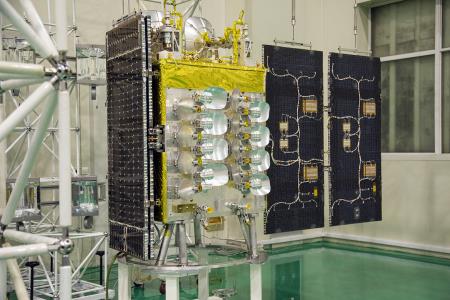First of its kind to provide broadband in Q/V band

China's first low-Earth orbit 5G satellite with capacity of 10Gbps. Photo: Galaxy Space
China's first low-Earth orbit 5G broadband satellite with a high data transmission capacity will be launched by the end of December, a move that will facilitate the ground transceivers' ability to provide full 5G coverage, experts said.
The satellite, developed by Chinese commercial aerospace company Galaxy Space, will be the first in China with data transmission capacity of 10 gigabits per second, and it will be the world's first low-Earth orbit broadband satellite in the Q/V band, an extremely high frequency band, according to the company.
The satellite has already been developed and ground tests have yielded stable results. Once in orbit, the satellite will be able to cover an area of 300,000 square kilometers, roughly 50 times the size of Shanghai, the company said.
The broad coverage of low-Earth orbit satellites could mean easier access to the internet for people in remote areas, as well as more simultaneous data transmission for time-sensitive industries, including live news broadcasts and trading, according to Zhang Shijie, an aerospace expert.
"The satellites will make a decisive change for traders, especially in high-frequency trading," Zhang said, adding that "financial institutes that use information provided by the satellites can notice changes in the market before their competitors."
Internet provided by satellites has gained more importance worldwide, as the cost of deploying 5G ground base stations becomes increasingly expensive compared with previous generations, Xing Qiang, an expert from the Small Rocket Studio, told the Global Times on Thursday.
"As the network speeds up, it requires a larger number of base stations to provide coverage," Xing said. "Low-earth orbit satellites with high spectrum can easily provide full coverage with the low latency that 5G networks need."
The launch is expected to narrow the technological gap between Chinese companies and US companies Oneweb and SpaceX, which have already deployed low-Earth orbit communications satellites.
"Technological breakthroughs, such as Q/V band loading technologies, are the key in narrowing the gap with leading companies in the world," Xu Ming, CEO of Galaxy Space, told the Global Times on Thursday.
US company SpaceX is already planning the world's largest low-Earth orbit broadband constellation - Starlink. As of November, it had deployed 122 satellites for Starlink, and the company has asked to arrange spectrum for 30,000 additional Starlink satellites, according to media reports.
As the global competition in network deployment heats up, demand for low-Earth spectrum resources will continue to grow, Xu said, and it is essential to deploy low-Earth orbit satellites as early as possible.
Newspaper headline: 5G satellite offers high capacity